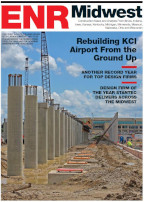...are building housing, research labs, and athletic facilities. The country’s demographics support construction of hospitals, clinics, and assisted-living facilities. And stimulus money should start trickling to municipal projects other than roads this year,” he says.
One of Ratio’s strategies for thriving is an ongoing effort to become more diverse—both in its range of services and in the geographic areas served. That diversity lessens the impact of downturns in any one sector or geographic area. In addition to its strong presence in Indiana and Illinois, Ratio now has customers as far away and North Carolina and Colorado.
Another Ratio strategy is working with private and public/private customers to help make projects happen. “You ask yourself what a community might need, then you work with key partners to help get the project going, rather than waiting for things to happen,” says Browne.
Greg Werner, vice president of Mortenson Construction in Chicago, thinks that 2010 will be flat, but with some improvement during the third and fourth quarters.
Werner expects the busiest sector to be federal government work, as the federal General Services Administration is projecting work funded by the ARRA stimulus bill. He also expects transportation work—including light-rail projects—to be somewhat strong. The hardest-hit sectors, he says, will be those that are developer driven, like retail and condo construction. In the middle ground, Werner expects to see K-12 schools, higher education, healthcare, and municipal-government projects.
Mortenson’s approach to succeeding in a down market is focusing on what it does best, and not branching out into new areas. “We feel that focusing on becoming even better in the types of work at which we’re expert gives us the best chance to excel,” says Werner, “although we also do take a few calculated risks.”
Leonard Toenjes, president of the Associated General Contractors of St. Louis, says early 2010 will see more decline, but a slow upturn will come later in the year.
“The industry is at a 15-year low now—and it hasn’t hit bottom yet. But the rate of decline is slowing and things will bottom out early in 2010,” he says.
| State | 2008 | 2009 | 2010 | Change: 10 vs 09 |
|---|---|---|---|---|
| Illinois | $4,385 | $2,929 | $3,833 | 30.88% |
| Indiana | $3,039 | $2,352 | $2,800 | 19.07% |
| Missouri | $2,304 | $1,652 | $2,061 | 24.78% |
| Wisconsin | $2,415 | $1,925 | $2,384 | 23.83% |
Even after the industry bottoms out, recovery will be gradual, says Toenjes. “We’re seeing the pig-through-the-python effect as the bad-credit problems of recent years work their way through the system. Lending won’t loosen up for another year.”
Toenjes says that water/wastewater treatment and healthcare will be stronger segments of the market, with transportation and education also holding solidly.
One emerging trend he sees is contractors looking for work in new—and sometimes distant—geographic areas. The search, he says, is leading them to develop the electronic tracking and communication systems to manage projects from a distance.
Dennis Lavallee is president of the St. Louis Council of Construction Consumers, a group of the larger and most frequent construction-service buyers in the St. Louis area. Its members range from developers to manufacturers, universities, healthcare facilities, petroleum companies, energy producers, governments, and the U.S. Army Corps of Engineers.
Lavallee says the level of work in the area is down significantly, and he expects it to remain low throughout the coming year.
The most active sector, he says, is the institutional segment, because the projects have financing or are self financed.
In addition to the availability of credit, key drivers that Lavallee thinks will determine how the industry will do...


